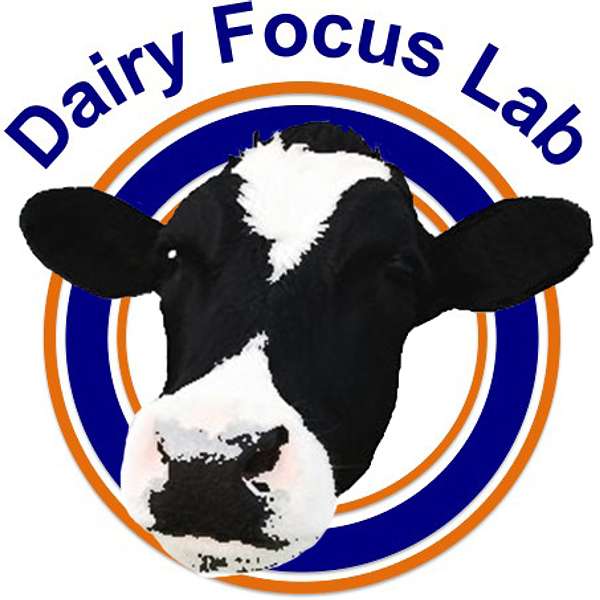
Dairy Focus PaperCast
Dairy Focus PaperCast
Effective nutritional strategies to mitigate enteric methane in dairy cattle
Methane is a potent greenhouse gas that traps energy far more efficiently than carbon dioxide. Reduction of methane emissions is thus essential to slowing climate change, and livestock are a major source of these emissions. Dr. Phil Cardoso talks with Dr. Alex Hristov of Penn State University about nutritional strategies for mitigating production of methane by dairy cattle. They discuss the effectiveness of several different feed additives at reducing methane emissions and their effects on DMI and milk production.
PaperCast is also available as an audio podcast!
Find us on: Apple Podcasts: https://podcasts.apple.com/us/podcast/dairy-focus-papercast/id1530748959
Spotify: https://open.spotify.com/show/223Pv4qwRcMFyyy3CXdL3r
Podcast Addict: https://podcastaddict.com/podcast/3098543
Podchaser: https://www.podchaser.com/podcasts/dairy-focus-papercast-1420022
RSS: https://feeds.buzzsprout.com/1327510.rss
Links to papers and other sources mentioned in this video
---------------------------------------------------------------
Hristov et al. 2022. Symposium review: Effective nutritional strategies to mitigate enteric methane in dairy cattle.
DOI: 10.3168/jds.2021-21398
https://www.journalofdairyscience.org/article/S0022-0302(22)00392-7/fulltext
International Methane Emissions Observatory (IMEO)
https://www.unep.org/explore-topics/energy/what-we-do/imeo
Joint EU-US Statement on the Global Methane Pledge
https://ec.europa.eu/commission/presscorner/detail/en/statement_21_5206
Hristov et al. 2015, An inhibitor persistently decreased enteric methane emission from dairy cows with no negative effect on milk production.
DOI: 10.1073/pnas.1504124112
https://www.pnas.org/doi/10.1073/pnas.1504124112
73rd Annual Meeting of EAAP. Porto, Portugal, September 5–9 2022.
https://eaap2022.org/docs/Final_Programme_EAAP22.pdf#page=53
Arndt et al. 2022, Full adoption of the most effective strategies to mitigate methane emissions by ruminants can help meet the 1.5 °C target by 2030 but not 2050.
DOI: 10.1073/pnas.2111294119
https://www.pnas.org/doi/10.1073/pnas.2111294119
Duin et al. 2016, Mode of action uncovered for the specific reduction of methane emissions from ruminants by the small molecule 3-nitrooxypropanol.
DOI: 10.1073/pnas.1600298113
Pitta et al. 2022, The effect of 3-nitrooxypropanol, a potent methane inhibitor, on ruminal microbial gene expression profiles in dairy cows.
DOI: 10.1186/s40168-022-01341-9
https://microbiomejournal.biomedcentral.com/articles/10.1186/s40168-022-01341-9
FAO-IPCC Expert Meeting on Climate Change, Land Use and Food Security. Rome, Italy January 23–25 2017.
https://www.fao.org/3/i7068e/i7068e.pdf
Hristov and Melgar 2020, Short communication: Relationship of dry matter intake with enteric methane emission measured with the GreenFeed system in dairy cows receiving a diet without or with 3-nitrooxypropanol.
DOI: 10.1017/S1751731120001731
https://www.sciencedirect.com/science/article/pii/S1751731120001731?via%3Dihub
https://globalresearchalliance.org/research/livestock/networks/feed-nutrition-network/
Hammond et al. 2016, Review of current in vivo measurement techniques for quantifying enteric methane emission from ruminants.
DOI: 10.1016/j.anifeedsci.2016.05.018
https://www.sciencedirect.com/science/article/abs/pii/S0377840116302048
Roque et al. 2019, Inclusion of Asparagopsis armata in lactating dairy cows’ diet reduces enteric methane emission by over 50 percent.
https://www.sciencedirect.com/science/article/abs/pii/S0959652619321559
DOI: 10.1016/j.jclepro.2019.06.193
Martins et al. 2022, Effects of feeding method and frequency on lactational
performance and enteric methane emission in dairy cows.
https://www.adsa.org/Portals/0/SiteContent/Docs/Meetings/2022ADSA/Abst